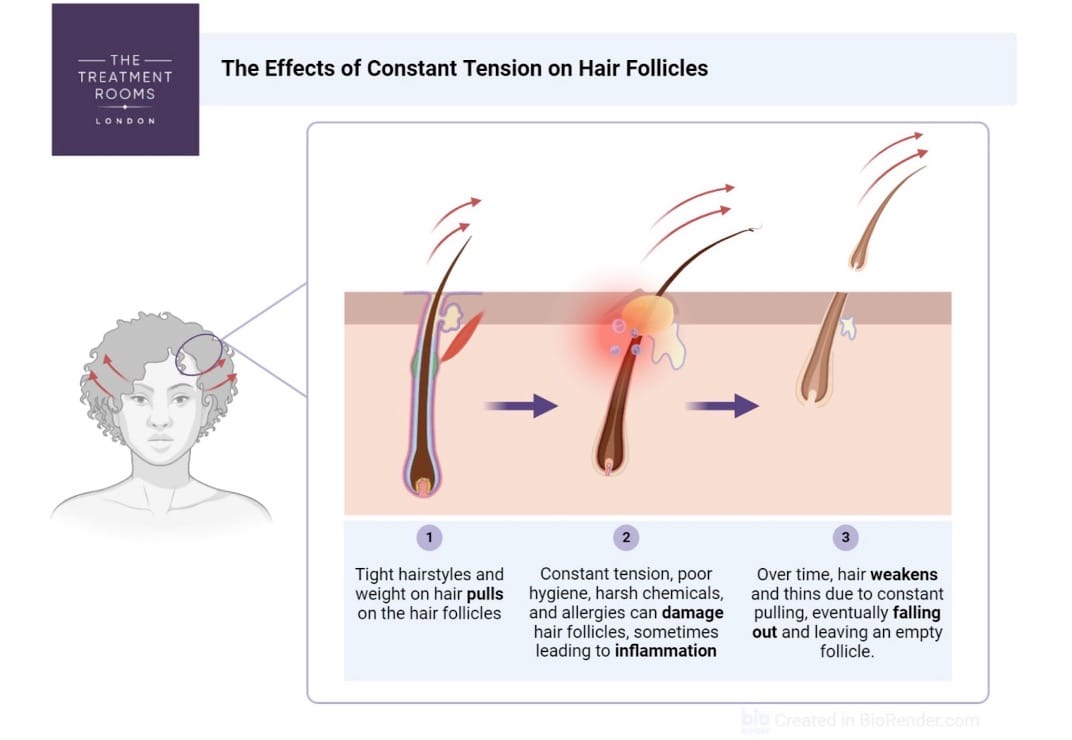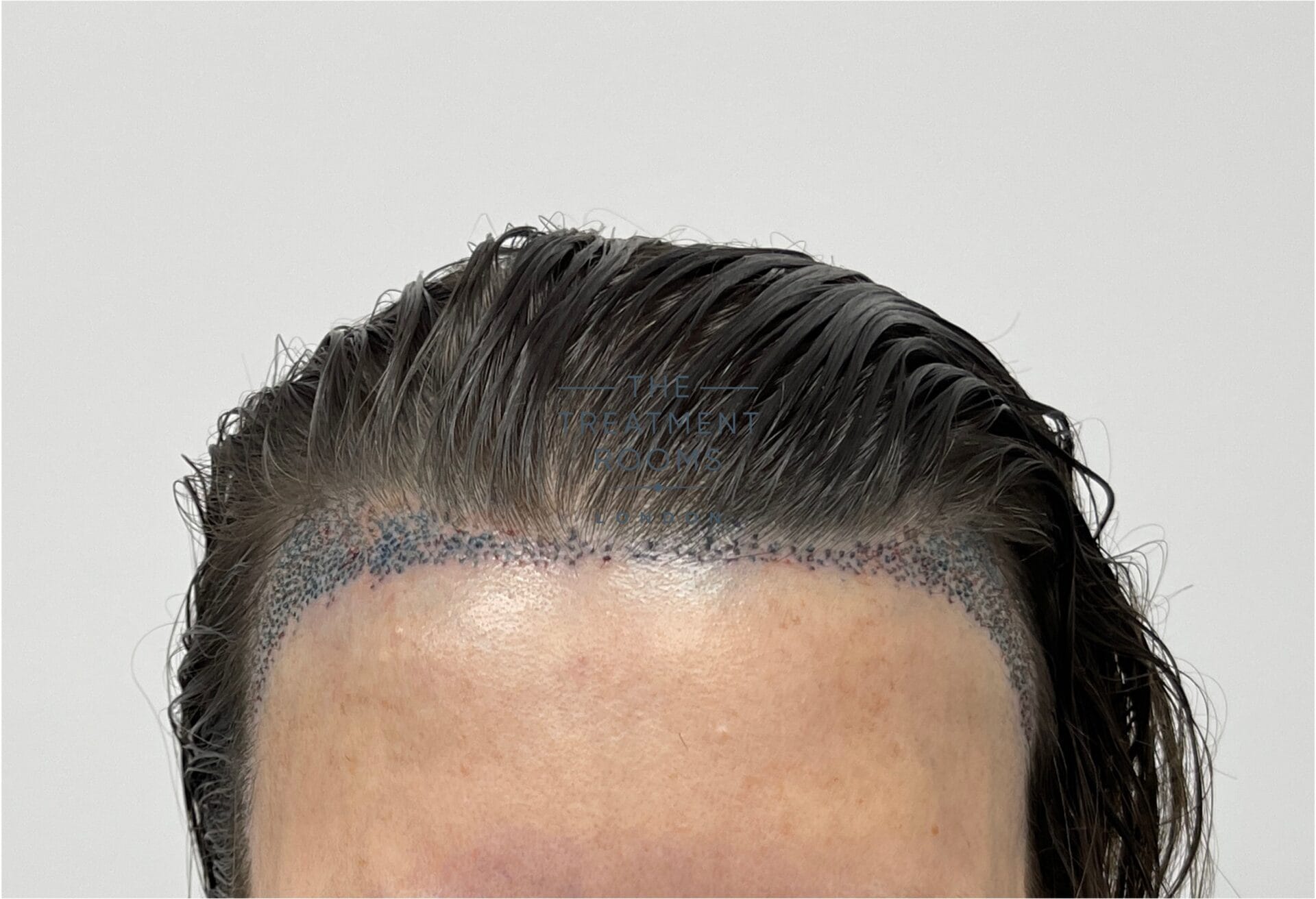Women can develop a widow’s peak at some point in life, either due to it being their natural hairline or hair loss in the form of female pattern baldness or traction alopecia1. Hair transplant surgery can be a useful treatment to reduce the appearance of a widow’s peak in women. This article will explore how.
What is a Widow’s Peak in Women?
A widow’s peak in women is a hairline shape where the hairline forms a point centred on the forehead. It’s characterised by a “V” or “M” shape. In some women, the hairline forms a straight, oval line across their forehead. However, in some individuals, hair growth is higher on either side in the temples. This causes a “peak” in the hairline at the centre.
The widow’s peak is often confused with a receding hairline. A widow’s peak is something you’re born with, whereas a receding hairline occurs over time due to age, stress, female pattern baldness or traction alopecia.

In women, the widow’s peak isn’t immediately apparent. It’s more evident if you pull your hair back, tracing your finger along the hairline, where, in the centre, it dips in a “V” or “M” shape.

Why Is It Called a Widow’s Peak?
The term “widow’s peak” comes from 18th-century England2. Back then, it was tradition that when the husband died, his wife would wear a black triangular hood or hat with a peak or bill falling down the centre of the forehead. Because the hairline resembles the beak of the hood, the name stuck.
Reverse widow’s peak
There is another type of hairline termed a ‘reverse widow’s peak’. As you might expect, this pattern is the exact opposite of a widow’s peak, with a ‘V’ shape going in the opposite direction.
While a reverse widow’s peak may occur due to a receding hairline in men, the pattern is also associated with frontal fibrosing alopecia, an autoimmune condition which often affects women.
Female Widow’s Peak Causes
Inheriting a Widow’s Peak as a woman
A widow’s peak in a female is often also seen in her parents, grandparents, or siblings. However, that’s not always the case, and we aren’t clear on how a widow’s peak in women is inherited. For most people, a widow’s peak is a common natural variant.
Female widow’s peak Associated with Hair Loss
It is worth noting that a widow’s peak in women can be associated with a receding hairline. Less common than in men, it can also occur due to severe stress, malnutrition, and menopause.
You can also develop a widow’s peak by repetitively tying your hair tightly, which can cause traction alopecia at the front of your hairline. This causes tension on the hair follicles, which over time causes them to weaken and fall out. This is summarised in the diagram below.

Genetic causes for a widow’s peak in women
In rare cases, it’s a sign of an underlying genetic condition, such as Donnai-Barrow Syndrome, Frontonasal Dysplasia, and Opitz G/BBB syndrome.
Female Widow’s Peak Treatment
The widow’s peak is a surprisingly common hairline. Some notable examples include Grace Kelly, Marilyn Monroe, Blake Lively, and Britney Spears.
While some people embrace their hairline, others do not find it an attractive feature. You may wish for it to be removed or minimised. Certain hairstyles, such as growing a fringe, will make it less apparent. However, if you like to wear your hair back or in a ponytail, it can expose your widow’s peak.
Potential options to change or flatten a widow’s peak in women include:
- Shaving. Trimming the widow’s peak using a razor is one solution. This is possible for a minor widow’s peak, but it is not viable if the peak is more pronounced. Your hair will also grow back, leaving a patch of stubble.
- Waxing and/or Sugaring. This works similarly to shaving but achieves a longer-lasting result. You will notice a patch of stubble within a few weeks, and the procedure must be repeated continually.
- Depilatory Creams. These creams cause your hair to fall out. They’re often hard to apply solely to the widow’s peak and can cause irritation or burns.
- Laser Hair Removal or Electrolysis. This is a permanent solution to remove a widow’s peak. However, it can take several sessions to achieve a lasting result.
An alternative option is a female window’s peak hair transplant. It involves straightening the hairline by adding new hairs to lower the hairline, creating a more uniform and feminine appearance.
Female Widow’s Peak Hair Transplant
A female’s widow’s peak hair transplant involves adding hair follicles to the hairline to create a straighter appearance. This can either eliminate the widow’s peak or minimise its appearance.
There are two potential mechanisms:
- Follicular unit excision (FUE) involves removing the individual hair follicles from the back or sides of the scalp. The follicles are excised using a hole punch technique. These follicles are then inserted in the hairline to create a more uniform look.
- Follicular unit transplantation (FUT) removes a thin strip of skin from the back of the scalp. The hair follicles are then extracted and transplanted into the hairline. FUT requires less shaving for women.
FUE minimises scarring and is the preferred option for mild widow’s peaks in women. However, in women with a pronounced widow’s peak, an FUT hair transplant may be required. The procedure involves more hair follicles, allowing your surgeon to achieve a denser final appearance. In both procedures, hairs are inserted individually, allowing your Surgeon to control the direction and density of follicles, achieving a natural look.
Widow’s peak vs receding hairline in women
A widow’s peak, a distinctive hairline shape in women, is relatively common and can be treated with surgery or hair styling methods. Sometimes it is associated with hair loss, causing a receding hairline; however, this is relatively uncommon compared to men who commonly have a widow’s peak and a receding hairline.
A receding hairline is a more general term that can also refer to thinning and balding at the temples, which is often caused by rarer conditions in females, such as temporal triangular alopecia.
How to get rid of a widow’s peak
There are various ways that you can treat a widow’s peak. These include:
- Changing hairstyle: your barber or hairdresser can recommend a hairstyle that makes a widow’s peak less noticeable and improves your appearance
- Use hair removal creams: you can buy creams (depilatories) that remove hair and will slow regrowth compared to shaving
- Waxing: You can remove hair by applying a layer of hard wax and removing it
- Electrolysis: a technique that uses heat to remove individual hairs and prevent regrowth
- Laser removal: using strong light beams to destroy the hair follicles. This method can stop hairs from growing back more effectively than most of the above methods
- Hair transplant: A hair transplant can correct a widow’s peak, and we’ll discuss this option in more detail in the next section

Cost For A Widow’s Peak Hair Transplant
A widow’s peak transplant can cost between £3,000 and £8,000, with the price dependent on how many grafts you require for your transplant and whether you opt for an unshaven or shaven hair transplant.
Widow’s peak hair transplant graft number and cost
If you have lost a minimal amount of hair on either side of your widow’s peak, you will require less hair to be transplanted. This will result in a lower overall cost for your widow’s hair transplant. Generally, hair transplant surgery for a widow’s peak can be categorised as small, medium or large.
Small widow’s peak hair transplant cost
Such cases can be seen here: small widow’s peak hair transplants, 500-900 grafts. The price for such surgery can range between £3,000 and £4,500.
Medium widow’s peak hair transplant cost
You may have lost a moderate amount in your temples, creating a deeper widow’s peak. This might require 900-1400 grafts to soften the widow’s peak appearance. As a result the cost for a medium sized widow’s peak hair transplant will range between £4,000- £5,500.
Large widow’s peak hair transplant cost
The more hair you have lost in your temples, the larger a surgery you may require for your widow’s peak. As a result, the cost for a large-sized widow’s peak hair transplant will be higher. Such cases can be found here: widow’s peak hair transplants, 1400-1800 grafts. The price for such surgery can range between £5,000 and £8,000.
Unshaven widow’s peak hair transplant cost
Some patients choose to undergo a non-shaven hair transplant, as only the temples on either side of the widow’s peak, as well as the donor area, will need to be shaved. This will allow the rest of your hair in the widow’s peak and behind to cover the temples and the places that have been operated on.
Women often style their hair into a fringe to help conceal the widow’s peak after a hair transplant.
Choosing to have an unshaven widow’s peak hair transplant will cost more, as the surgery will take more time and diligence by your Surgeon. As a result, you can expect an unshaven widow’s peak hair transplant to cost more than a regular shaven widow’s peak hair transplant.
Widow’s peak hair transplant finance
The Treatment Rooms London offers 12-month 0% finance options to patients looking to finance the cost of their widow’s peak hair transplant. If you’re interested in learning more about our financing options for your hair transplant, please don’t hesitate to contact us.
Is a Hair Transplant for a Woman’s Widow’s Peak a Good Idea?
For women seeking to change the shape of their widow’s peak and achieve a rounder-looking hairline, the procedure offers a long-lasting correction to the peaked appearance. It takes approximately 1 day to complete, followed by a 7–10 day recovery period.
At The Treatment Rooms London, we’re experts in evaluating your hairline and determining the best approach to correcting any issues. Our patients achieve remarkable results, resulting in a more uniform and even hairline.
During the initial personalised consultation, we will advise you on whether an FUE or FUT technique is needed. We always work to minimise scarring and maximise the eventual hair growth. We can also advise on unshaven hair transplant options for women who want extra discretion.
Conclusion
Living with a widow’s peak doesn’t have to be permanent. Whether your hairline is genetic or your hair has receded slightly, we can help. With our corrective treatments, we’ll restore your hairline to create the even appearance you’re after.
At The Treatment Room London, we offer both FUE and FUT hair transplants for women with a widow’s peak. Our surgeons will guide you through the procedure, detailing the best options for your specific hair needs. To book a consultation, use our contact form or call 020 8706 0076.
References
- Cleveland Clinic. Hair Loss in Women. Available at: https://my.clevelandclinic.org/health/diseases/16921-hair-loss-in-women
- WebMD. What to Know About Widow’s Peak. Available at: https://www.webmd.com/beauty/what-to-know-about-widows-peak
- Rassman W. Phenotype of normal hairline maturation. Facial Plastic Surgery Clinics. 2013 Aug 1. Available at: https://www.facialplastic.theclinics.com/article/S1064-7406(23)00102-5/abstract
- Kyriakou G, Glentis A, Papanikolaou S. Widow’s peak: a usually overlooked, yet significant morphogenetic trait. JDDG: Journal der Deutschen Dermatologischen Gesellschaft. 2021 Sep;19(9):1271-5. Available at: https://onlinelibrary.wiley.com/doi/abs/10.1111/ddg.14502
- The Treatment Rooms London. FUE vs FUT: Which Hair Transplant Is Best For You? Available at: https://www.treatmentroomslondon.com/hair-transplant-surgery/fue-vs-fut/
Share:
Authored by
Reviewed by
Book a Consultation
Related Blogs
Castor Oil (Ricino Oil) for Hair Growth: Benefits, Uses & How to Apply for Maximum Results
June 26, 2025
Castor oil, also known as Ricino oil, is extracted from the Castor bean plant (Ricinus communis). During…
What is a Hair Transplant? How it Works, Success Rate & What to Expect
June 23, 2025
Hair transplantation is a cosmetic surgical procedure that restores hair by moving healthy follicles from one part…
John Cena Hair Transplant
May 14, 2025
John Cena, a common household name, is a figure who has effortlessly straddled the worlds of professional…
Kyle Walker Hair Transplant: Before, After, and His New Hairline
May 12, 2025
Kyle Walker is known for his defensive skills at Tottenham Hotspur, Manchester City, and in the England…
Celebrity Hair Transplants: Full Before and After Analysis
May 8, 2025
Elon Musk Hair Transplant Elon Musk, the billionaire behind Tesla and SpaceX, is well-known for his innovations…
Lewis Hamilton Hair Transplant: Before, After, and His New Hairline
May 7, 2025
As a top-class racing driver, Hamilton is used to wearing a race helmet. While this does protect…
James Nesbitt Hair Transplant: Before, After, and His New Hairline
May 6, 2025
James Nesbitt, the Northern Irish actor famed for his role as Adam Williams in the British comedy-drama…
How Many Hair Grafts Do You Need For A FUE Hair Transplant?
May 3, 2025
An Follicular Unit Excision (FUE) or FUT hair transplant are 2 main procedures available to address hair…
Cristiano Ronaldo’s Hair and Hairline
May 2, 2025
Cristiano Ronaldo, the football icon, is celebrated as much for his on-field brilliance as his impeccably groomed…











